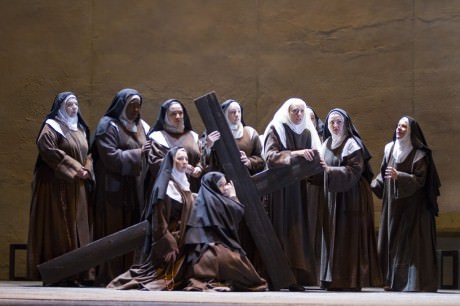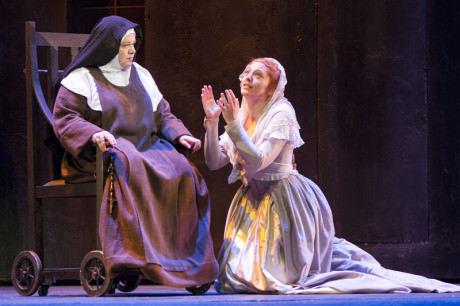A penetrating and extremely lucid psychological austerity permeates the current production of the Washington National Opera’s (WNO) Dialogues of the Carmelites by composer and librettist Francis Poulenc (after a play by composer Georges Bernanos). This most modern of operas (in sensibility —for the opera takes place in 1789 to 1794) presents universal and ever-constant traditional Catholic themes of death, fear, guilt, martyrdom, atonement and redemption as witnessed through several fascinating principals and a superior ensemble cast of characters who portray Carmelite nuns living behind cloistered walls. All technical elements of this intriguing presentation of this somewhat rarefied and specialized of operas, mirror the claustrophobic, “hothouse” atmosphere of very individual personalities trying to come to terms with their spiritual callings behind closed walls.

Sung here –at the WNO—in English (with English subtitles) and conducted with musical flair and subtlety by conductor Antony Walker, the sheer length of this opera and the challenging psychological themes can be initially daunting and the utmost attention and patience of the audience member is mandatory for ultimate appreciation of this most refined and discerning of operas. As directed by Artistic Director Francesca Zambello, the tone of the opera is embedded in the emotional undercurrents that lie right underneath a succession of almost continual operatic “dialogues” between these soul-searching characters. As they try to find their moorings behind the closed walls of their cloistered convent, dramatic heft is added to the proceedings as we witness the “ant-clerical “ regulations and laws of the French Revolution intruding-in the most disastrous and tragic way imaginable —-on this group of nuns who are bound together in sisterhood and spiritual solidarity.
As the pivotal character in the opera, Canadian Soprano Lela Claire (Blanche de la Force), sings with a lustrous and piercing purity of tone. Indeed, as she makes her WNO debut, Ms. Claire, appropriately conveys the mood of the young and somewhat confused ingénue. Claire sings quite sensitively and moves extremely well but does not quite possess the vocal interpretative charismatic edge required for the very demanding role of the neurasthenic, intense, and moody central character of Blanche. This slight mild weakness, however, is well-balanced by the superior talents of the remaining principals and the technical components of this absorbing and reflective production.
As the aging, dying prioress (Madame De Croissy), world-renowned American mezzo-soprano Dolora Zajick, interprets ever moment and every inflection with understanding and ease. Zajick’s aria as she rails against the untidy, undignified way she must die in the presence of her religious community is a powerhouse of a scene with Zajick alternately raging at God, mocking her fate and holding on to her faith through grim determination. Zajick’s resonant chest tones were a pleasure to hear.
American mezzo-soprano Elizabeth Bishop (Mother Marie) as the mentor to the idealistic Blanche, and as a candidate for the new Prioress shines with the sheer versatility of her voice and her authoritative yet natural stage presence. Bishop’s aria as she sings forthrightly of the various duties of a nun, is a musical highlight among many other highlights.
American soprano Leah Crocetto (Madame Lidoine) as the new Prioress who insists on the power of prayer in lieu of an overt seeking of martyrdom is a wonder to behold in all aspects. Her gorgeous soprano can ascend to the loftiest height and, conversely, plummet to the lower depths with fluidity and ease. Her acting and interpretive skills are unstudied and effortlessly natural. Crocetto’s aria when she decides to join her fellow nuns in the vow of martyrdom is a moment of pure operatic bliss. Palpable joy is conveyed as Crocetto sings with new –found fervor and acceptance of the need for martyrdom.
American soprano Ashley Emerson (Sister Constance) as the more upbeat and positive member of the community sings well in a brisk and refreshing style and America tenor Robert Baker also makes a very strong impression as the Chaplain .
As alluded to earlier, all technical elements of this opera aid immeasurably in mirroring the tightly-coiled and spiritually sensuous nature of this community fighting for survival in a hostile world. Exquisite Lighting by American designer Mark McCullough intertwines textured and browns and natural colors to highlight stylized tableau and beautifully-lit soft-lit composite focused visual compositions. Many of McCullough’s visuals made me think of certain Vermeer paintings.
The incredibly innovative and functionally appropriate Scenic Design by German designer Hildegard Bechtel helped to emphasize the “hothouse” and intensely confining purview of this opera. Utilizing a succession of revolving and, alternately, closing panels and walls-the oppressive nature of the historical forces at play here and the confined, binding nature of the cloister walls was organically displayed.
Costumes by Designer Claudie Gastine were historically correct for the period and emphasized natural textures and colors.
The final scene is moving beyond belief. As presented here and lit so beautifully by McCullough, as we witness the procession of nuns voluntarily sacrificing their lives to the blade of the guillotine to the strains of the “Salve Regina,” tears are hard to keep at bay. The historical forces of the period and the personal convictions of these “sisters-in-martyrdom” have merged to produce an extremely cathartic and immensely stirring moment in the operatic repertoire.

I could not help but think of another similar occurrence-namely, the anguished sacrificing of the nuns to God’s awful grace-as they were swallowed by the ferocious waves of the storm-tossed ship, the “Deutschland” (in Gerard Manley Hopkins’epic poem “The Wreck of the Deutschland”).
The Washington National Opera should be very proud of rising to the occasion with the production of this challenging and finely–wrought opera.
Running Time: Three hours, with a 20-minute intermission.
Dialogues of the Carmelites by the Washington National Opera –continues through March 10, 2015 at The Kennedy Center Opera House at the John F. Kennedy Center for the Performing Arts-2700 F Street, NW in Washington, DC. For ticket, call the box office at (800) 444-1324, or (202) 467-4600, or purchase them online.




